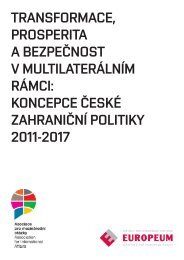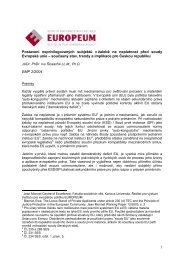eu constitutionalisation - EUROPEUM Institute for European Policy
eu constitutionalisation - EUROPEUM Institute for European Policy
eu constitutionalisation - EUROPEUM Institute for European Policy
Create successful ePaper yourself
Turn your PDF publications into a flip-book with our unique Google optimized e-Paper software.
Chapter 1: Constitutionalisation: the Case of the Convention as a Network AnalysisThe process of the Convention, the representation of different interests, aswell as the modes of communication and ways of negotiation and compromiseseeking can itself be perceived as a concentrated and condensedintegration process and thus theories of <strong>European</strong> integration can beapplied, perhaps somewhat loosely. Hence the Convention can be seenas a laboratory or microcosm of the integration process.This paper analyses the communication processes at the Convention, approachesto consensus-building among different segments and groupings, theinteraction among different actors, their roles and influence. The Conventionprocess is open to many different analytical approaches and this paper willthus examine the balance and applicability of different integration theoriesaccordingly. The paradigms which view the nation state as the leading EUactor have great potency and must be one of theoretical approaches examined.⁵Although this approach EU acknowledges that integration involves ‘deepening’(more and more power is transferred to EU institutions) it is the nationstate which is a “key agent in determining the pace of <strong>European</strong> integrationand the extent to which sovereignty is being pooled within that polity.”⁶ Theopposite paradigm is to perceive the EU as a sort of quasi federation with its owninstitutional or <strong>European</strong> interests. This acknowledges a growing numbers ofactors and players creating different networks which operate on the basis ofever-growing functional interdependence on the <strong>European</strong> stage.⁷ The paperattempts to explain that, while major theories are useful tools to uncover thescale of enquiry needed, they in the event fail to provide a complete picture ofthe multifaceted and complex nature of <strong>European</strong> integration. Analysis of theConvention needs a broader theoretical framework, which requires a divisionof whole the process into several separate layers. It is then appropriate to applydifferent theoretical approaches to each of these layers.Finding the theoretical toolIn their analysis of the bargaining processes in the 2004 IGC (find thischapter later in this volume) Etain Tannam and Brigid Laffan examine two5) According to Dehousse “the conventional [unitary] vision of the state ignores the centrifugal effectsof integration, which have led to a fragmentation of state structures and the emergence of functionalnetworks among the institutions of governance in the various member states.” See RHODES, HEYWOODand WRIGHT (1997), p. 396) Ibid., p. 97) Ibid., p. 4122Chapter 1: Constitutionalisation: the Case of the Convention as a Network Analysisgrand theories: neo-functionalism and liberal intergovernmentalism as themost suitable theories. They consider that “the crux of neo-functionalism’svalidity rests on whether the Convention’s provisions and its influence onthe IGC reflect national self-interest and conflicts between states or common‘upgraded’ interests shared by EU states.” For intergovernmental institutionalists,the Franco-German partnership with periodic British backing plays thecrucial role in their intergovernmental bargains. Tannam and Laffan arguethat the application of these two grand theories leads to a significant simplificationof the multifaceted entity and diversified policies on many levels ofthe decision-making and law-making processes. To avoid this simplificationthe authors propose using the theories of ‘mezzo-level school’. These includefusion theories, historical institutionalism, sociological institutionalism andsocial constructivism, which seems more appropriate and helpful.⁸In “<strong>European</strong> Integration and the nation state”, Renaud Dehousse statesthat state-centric approaches to understand <strong>European</strong> integration tend tosee the relations between nation states and the EU as a zero-sum game:powers conferred on the <strong>for</strong>mer are necessarily taken away from the latter.The intergovernmentalists need independent bodies – nation states – toensure the effective implementation of interstate bargains or, as argued byAndrew Moravcsik, to identify areas in which national preferences seemto have converged at a given time.⁹ On the other hand, neo-functionalismsupposes that actors tend to expand the scope of mutual commitment andlead to a widening of the functional scope of EU law, creating an increasingnumber of treaty provisions <strong>for</strong> a growing number of policy fields.Thus the EU plays the role of “a ‘political promoter’ which <strong>for</strong>mulates farreaching policy agendas, articulates ideals and brokers strategies <strong>for</strong> thedeepening of the integration process. The influence of national actorswould wither away.”¹⁰ Both approaches simultaneously simplify the processwhich also relates to the issues solved, actors involved, and the timing.To some extent, organized interest is accounted <strong>for</strong> in the neo-functionalistapproach. Network analysis has mostly concentrated on a more narrowscope – mostly linked with the governance approach. It thus doesnot seek to explain ‘why integration occurs’ (the intergovernmental andneo-functionalist question) but rather addresses the more narrow issue of‘how do interests organize to influence supra-national decision-making’8) Ibid., p. 89) Ibid., p.4710) WESSELS, MAURER and MITTAG (2003), p. 1023








